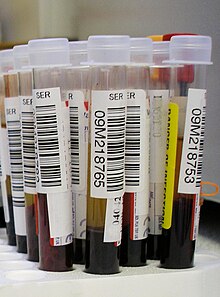Blood test
A blood test , also known as bloodwork, is a laboratory analysis performed on a blood sample that is usually extracted from a vein in the arm using a needle, or via fingerprick. Blood tests[1] (also referred to as blood work) are used to determine physiological and biochemical states, such asdisease, mineral content, drug effectiveness, and organ function. They are also used in drug tests.
Extraction[edit]
Venipuncture is useful as it is a minimally invasive way to obtain cells and extracellular fluid (plasma) from the body for analysis. Since blood flows throughout the body, acting as a medium for providingoxygen and nutrients, and drawing waste products back to the excretory systems for disposal, the state of the bloodstream affects, or is affected by, many medical conditions. For these reasons, blood tests are the most commonly performed medical tests.[2]
If only a few drops of blood are needed, a fingerstick is performed instead of drawing blood from a vein.[3]
Phlebotomists, laboratory practitioners and nurses are those charged with patient blood extraction. However, in special circumstances, and emergency situations, paramedics and physicians sometimes extract blood. Also, respiratory therapists are trained to extract arterial blood to examine arterial blood gases.[4][5]
Types of blood tests[edit]
Biochemical analysis[edit]
A basic metabolic panel measures sodium, potassium, chloride, bicarbonate, blood urea nitrogen(BUN), magnesium, creatinine, glucose, and sometimes includes calcium. Blood tests focusing on cholesterol levels can determine LDL and HDL cholesterol levels, as well as triglyceride levels.[6]
Some blood tests, such as those that measure glucose or a lipid profile, require fasting (or no food consumption) eight to twelve hours prior to the drawing of the blood sample.[7]
For the majority of blood tests, blood is usually obtained from the patient's vein. However, other specialized blood tests, such as the arterial blood gas, require blood extracted from an artery. Blood gas analysis of arterial blood is primarily used to monitor carbon dioxide and oxygen levels related topulmonary function, but it is also used to measure blood pH and bicarbonate levels for certain metabolic conditions.[8]
While the regular glucose test is taken at a certain point in time, the glucose tolerance test involves repeated testing to determine the rate at which glucose is processed by the body.[9]
Normal ranges[edit]
Blood tests results should always be interpreted using the ranges provided by the laboratory that performed the test. Example ranges are shown below:
| Test[10][11] | Low | High | Unit | Comments |
|---|---|---|---|---|
| Sodium (Na) | 136 | 145 | mmol/L | |
| Potassium (K) | 3.5 | 5.0 | mmol/L | |
| Urea | 2.5 | 6.4 | mmol/L | BUN - blood urea nitrogen |
| Urea | 15 | 40 | mg/dL | |
| Creatinine - male | 62 | 115 | μmol/L | |
| Creatinine - female | 53 | 97 | μmol/L | |
| Creatinine - male | 0.7 | 1.3 | mg/dL | |
| Creatinine - female | 0.6 | 1.2 | mg/dL | |
| Glucose (fasting) | 3.9 | 5.8 | mmol/L | See also glycated hemoglobin |
| Glucose (fasting) | 70 | 120 | mg/dL |
Molecular profiles[edit]
- Protein electrophoresis (general technique—not a specific test)
- Western blot (general technique—not a specific test)
- Liver function tests
- Polymerase chain reaction (DNA). DNA profiling is today possible with even very small quantities of blood: this is commonly used in forensic science, but is now also part of the diagnostic process of many disorders.
- Northern blot (RNA)
- Sexually transmitted diseases
Cellular evaluation[edit]
- Full blood count (or "complete blood count")
- Hematocrit and MCV ("mean corpuscular volume")
- Erythrocyte sedimentation rate (ESR)
- Cross-matching. Determination of blood type for blood transfusion or transplants
- Blood cultures are commonly taken if infection is suspected. Positive cultures and resulting sensitivity results are often useful in guiding medical treatment.
'연구하는 인생 > Natural Therapy' 카테고리의 다른 글
| Body composition (0) | 2014.02.28 |
|---|---|
| Types of Blood Tests (0) | 2014.02.26 |
| ** Kidney Cleanses - some highlights from Dr Richard Schulze and Dr Hulda Clark (0) | 2014.02.25 |
| ** How to Do a Kidney Cleansing Fast (0) | 2014.02.25 |
| Dr. Hulda Clark’s Herbal Kidney Cleanse (0) | 2014.02.25 |

